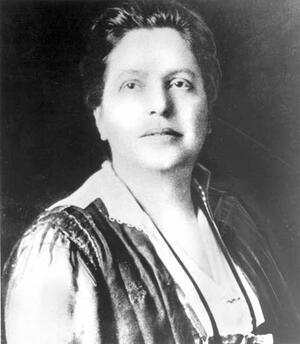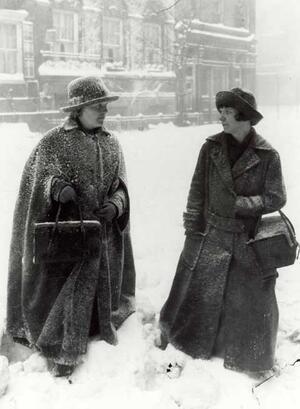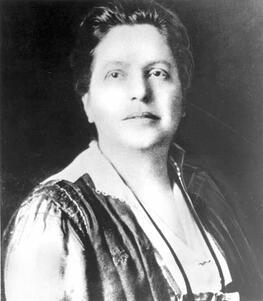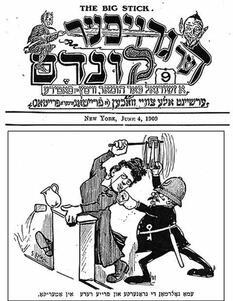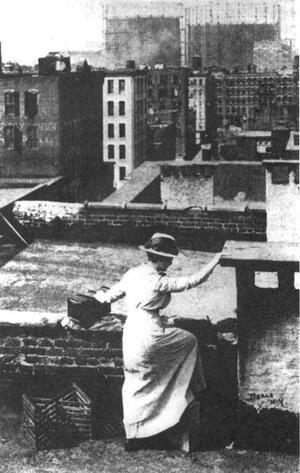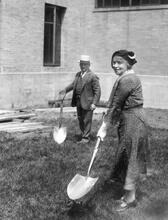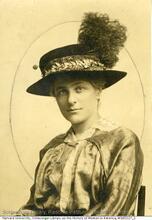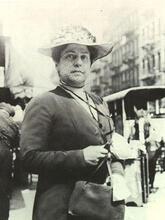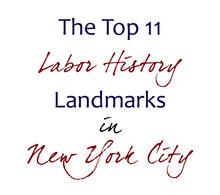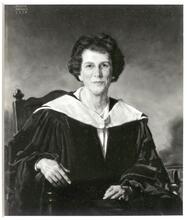Nursing in the United States
Early nursing in the United States mainly excluded Jewish women. Christian underpinnings in nursing education continued to be evident in the United States as late as the 1950s, and careful Jewish quotas on admittance to nursing school were maintained well into the twentieth century, stunting the prominence of Jewish nurses. Nevertheless, Jewish women have served as nurses. Early Jewish American nurses were “pioneers” for entering the field during a time when organized nursing attempted to strengthen its case for a closed profession by establishing entrance requirements and insisting on the registration of its members. Jewish nurses served with distinction in every instance where American soldiers have been mobilized. Despite significant barriers, Jewish nurses have even provided leadership to the profession and contributed to reform efforts.
Overview
Early in the twentieth century, trained nursing was not considered a suitable profession for a young Jewish woman. Patriarchal values dominated Jewish family culture. Women’s personal desires for education were often set aside. Long periods of training were also not acceptable to women who had to consider the economic needs of their families. To quote a Jewish garment worker, Bea Heller, “It didn’t pay in the hospitals, so I had to quit and go back to the factory” (Ewen 1985).
It is interesting to ponder what might have motivated members of an ethnic group to enter a profession that, at least on the surface, seemed to embrace an incongruous belief system. Jews are an ethnic minority who first faced quotas in being admitted to nursing schools and then discrimination in being hired by non-Jewish hospitals. Ethnicity could quickly be established with the requirement of a letter of recommendation from a member of the clergy. Jewish hospitals were organized because Jewish physicians frequently could not obtain attending rights at non-Jewish hospitals. Also, Jewish hospitals understood dietary requirements and observances that made Jewish patients more comfortable.
History of Early American Nursing
In order to examine the role Jewish nurses played in the establishment of modern American nursing, it is necessary to focus on some early American nursing history. In the United States, in 1839, as a result of an urgent appeal from Dr. Joseph Warrington, director of the Philadelphia Dispensary, a number of women in the community organized themselves into the Nurse Society. As Adelaide Nutting stated in History of Nursing and Source Book for Nursing (1904), “The preamble to their constitution stated that ... the undersigned, ... do associate for the purpose of providing, sustaining, and causing to be instructed as far as possible, pious and prudent women.”
The cause of training nurses was advanced by Dr. Samuel Gross, a founder of the American Medical Association. In 1869, Gross submitted a committee report resolving that “every large and well-organized hospital should have a school for the training of nurses, not only for the supply of its own necessities, but for private families, the teaching to be furnished by its own medical staff, assisted by the resident physicians.” Interest in schools continued to grow, and by 1890 there were more than thirty-five schools of nursing in the United States, modeled along the Nightingale system.
First attempts in nursing care were related to maternity nursing and the care of children. Nursing was seen as an extension of the nurturing and mothering role. Victorian morality prohibited women from caring for male patients who were not related to the household.
Nursing schools were developing in such a way that the demands on a probationer and subsequent nursing student would not permit a marriage relationship or dependent children. The age range most desirable for entering nursing school was the age at which most women made the decision to work or marry. The decision to enter nursing, therefore, meant choosing between a career or marriage. Marriage, a home, and children comprised the sought norm of the time for both Jewish and non-Jewish women. In fact, all activities in social work, hospital boards, and similar projects were seen as an extension of the mothering and nurturing role first exhibited in the home.
Nurses were trained in an arena of Christian spirituality with enormous emphasis on moral character. Christian underpinnings in nursing education continued to be evident in the United States as late as the 1950s. The Jamieson and Sewell series of nursing history texts, widely used in training programs, were written from the socio-Christian perspective. It was common practice to require nursing students to attend prayer time each morning and read aloud from the New Testament. Jewish students were not exempted from this practice, although they may have found it to be objectionable. A student may have been required to stay after prayers and give an explanation to the superintendent of nurses for not reading out loud. This practice continued well into the 1940s.
During the Civil War years, Phoebe Yates Levy Pember, not a trained nurse, distinguished herself as matron and administrator of the large Chimborazo Hospital in Richmond, Virginia, capital of the Confederacy. During this same time, another Jewish woman, Hanna Sandusky, distinguished herself as a midwife in Pittsburgh, Pennsylvania. Originally trained by her midwife mother in Eastern Europe, she arrived in the United States with her son in 1861 to join her husband. She became involved in attending to mothers delivering babies in the densely populated Hill District. Since grandmothers frequently attended at births, and the Yiddish word for grandmother is bobba, she quickly became affectionately known as Bobba Hannah. Her extraordinary skill was noticed by a local physician. He paid the expenses for Bobba Hannah and her son, who had eye problems, to seek medical attention in Germany. There she attended a school of midwifery and worked as a midwife before returning to Pittsburgh with a German diploma. A truly righteous woman, she served as a matchmaker, collected money and linens to marry off poor girls, and sewed shrouds for the dead. She never charged a fee and presided at 3,571 registered births, her last, at age eighty-two, in 1909.
Integration of Jewish Women into Nursing
In A Generation of Women: Education in the Lives of Progressive Reformers (1979), Ellen Lagemann termed her research subjects the “progressive generation” because they were a “pioneer” generation in the history of American women. Early nursing leaders functioned in a male-defined world, on their own terms. Early Jewish American nurses were “pioneers” for entering the field during a time when organized nursing attempted to strengthen its case for a closed profession by establishing entrance requirements and insisting on the registration of its members. Early leaders during this period included Lillian Wald, Amelia Greenwald, Naomi Deutsch, Blanche Pfefferkorn, and Regina Kaplan. Rae Landy and Rose Kaplan were the first American nurses in Palestine as Hadassah was being established. Another interesting personality, Emma Goldman, attended midwifery school in Vienna, Austria, and returned to the Lower East Side to work as a midwife among the indigent Jewish immigrants.
Josephine Goldmark’s report on the poor state of nursing schools, and often poor conditions for the students, helped reform many nursing programs. Most graduate nurses worked in homes and not hospitals, and tours of duty could often be twenty-four hours. She was an active member of the Henry Street Visiting Nurses Association and probably influenced Lillian Wald.
The New England Hospital for Women and Children in Boston, Massachusetts, was incorporated on March 18, 1863, with a charter calling for the admission of one Negro and one Jew to each class. The first trained African-American nurse, Mary Eliza Mahoney, graduated from that school on August 1, 1879. The names of the first trained Jewish nurses in America, following the tradition of Florence Nightingale, and their contributions are still undocumented. Jewish women, however, became trained nurses, even if they had to attend Catholic nursing schools, which several Jewish women did.
In 1873, Bellevue Hospital in New York City established its school of nursing. That same year, New Haven Hospital and Massachusetts General Hospital also established schools. Mount Sinai Hospital, in New York City, opened the Mount Sinai Training School for Nurses in March 1881. The newly formed school had no difficulty in attracting students. While the Mount Sinai Training School for Nurses was nonsectarian, constant efforts were made to attract eligible Jewish girls. Thirty such applications were received during the first year; seventeen applicants were accepted into the first class of forty-three. It was a requirement to pass an examination in reading, penmanship, simple arithmetic, and English or German dictation. Of course, it was not possible to have Friday evenings and Saturdays off. These requirements would have been daunting to many immigrant Jewish girls, whose schooling and resources were limited. It is remarkable that young Jewish women became nurses in a climate where schools began in non-Jewish populated centers, and where young women had to have “suitable acquirements and character,” as well as being “pious”—terms not generally well defined.
Evelyn Benson, in her research, has found that Jewish nurses served with distinction in the Spanish Civil War. In fact, Jewish nurses served with distinction in World War I and World War II, as well as in every instance where American soldiers have been mobilized.
Mathilda Scheuer was president of the American Nurses Association during the time that attempts were made to end racial discrimination within the organization. One area of contention was the scheduling of annual organizational membership meetings during The Jewish New Year, held on the first and second days of the Hebrew month of Tishrei. Referred to alternatively as the "Day of Judgement" and the "Day of Blowing" (of the shofar).Rosh Ha-Shanah or The Day of Atonement, which falls on the 10th day of the Hebrew month of Tishrei and is devoted to prayer and fasting.Yom Kippur. There is evidence of considerable correspondence between the alumni associations of Jewish training schools and the professional organizations trying to remedy this situation. However, some replies were not receptive to considering changing the dates of meetings.
Jewish nurses who have provided leadership to the profession since the middle of the twentieth century include Rachel Bliss, Felissa Cohen, Adele Herwitz, and Ingeborg Mauksch. Thelma Schorr retired as editor of the American Journal of Nursing. June Rothberg, Jacqueline Rose Hott, Claire Fagin, Harriet Feldman, and Janice Selekman have been deans at schools of nursing. Nettie Birnbach only recently stepped down as president of the New York State Nurses Association. The list is extensive. Jewish nurses are frequently leaders of non-nursing organizations as well.
Careful Jewish quotas on admittance to nursing school were maintained, probably until the establishment of the U.S. Cadet Nurse Corps in 1943, when the government paid the expenses for the cadet students. In Making Choices, Taking Chances: Nurse Leaders Tell Their Stories (1988), Myra Levine, professor emerita, University of Illinois College of Nursing, described her own experience with quotas in attempting to gain admission to Michael Reese Hospital School of Nursing in 1940.
Moving nursing education into the collegiate setting resulted in an increase in Jewish nurses. The elimination of quotas on school admissions also helped. A college education and being able to live at home made a career in nursing acceptable to Jewish parents. Another factor responsible for increased numbers of Jewish nurses was the large-scale employment of nurses in hospitals and industry, instead of individual employment in private homes, from World War II onward.
Hadassah Nurses Councils were formed in 1989 to encourage Jewish nurses to join and network together. The Raphael Society of the Association of Orthodox Jewish Scientists also encourages Jewish nurses to join. The many and varied accomplishments of Jewish women in nursing are finally being chronicled.
Benson, Evelyn R. “Mathilda Scheuer (1890–1974): A Biographical Sketch.” Journal of Nursing History 2, no. 1 (1986): 36–42.
Carnegie, M. Elizabeth. The Path We Tread: Blacks in Nursing, 1854–1990 (1991).
Ewen, Elizabeth. Immigrant Women in the Land of Dollars: Life and Culture on the Lower East Side, 1890–1925 (1985).
Hirsh, Joseph, and Beka Doherty. The First Hundred Years of The Mount Sinai Hospital of New York: 1852–1952 (1952).
Lagemann, Ellen. A Generation of Women: Education in the Lives of Progressive Reformers (1979).
Levine, Myra. Making Choices, Taking Chances: Nurse Leaders Tell Their Stories. Edited by Thelma Schorr and Anne Zimmerman (1988).
Maggs, Christopher. Origins of General Nursing (1983).
Morton, Marian J. Emma Goldman and the American Left: Nowhere at Home (1992).
Nutting, Adelaide. History of Nursing and Source Book for Nursing (1904).
Prince, Ethel. Communication with Grace Ryan, September 14, 1947. Archives. Box 6, Folder 12. School of Nursing, Jewish Hospital of Brooklyn, and New York State Nurses Association, Guilderland, N.Y.
Selavan, Ida Cohen. “Bobba Hannah, Midwife.” American Journal of Nursing 4 (1973): 681–683.

